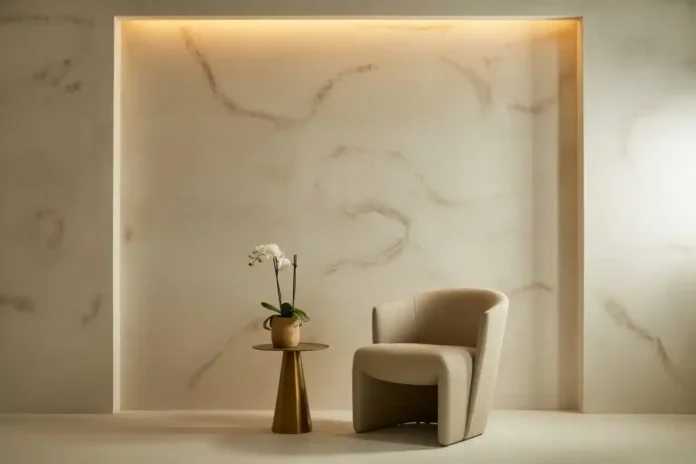Walls do more than separate a room they determine the ambiance of how a room will feel. When it comes to finishes that are both stylish and meaningful, Italian wall treatments take center stage. The finishes, based on historic techniques and materials, bring texture and depth in a manner simple paint or wallpaper can’t possibly deliver.
Whether restoring a period property, designing a luxury retail space, or simply injecting a bit of sophistication into the home, Italian wall finishes are a clever way to introduce character and lasting style. Here, we trace their history, designs, and why they remain so appealing to architects and interior designers.
Also read: The Unique Art of Lifestyle Fashion Luxury Management
A Heritage of Craftsmanship:
Italian wall finishes have been around since ancient times and were refined during the Renaissance era. The art was mastered by artisans in Florence and Venice cities with lime-based plasters, natural pigments, and hand-applied coats to create finishes that were not just dramatic but also long-lasting.
These finishes were not just cosmetic they protected and also allowed walls to breathe. Most of Italy’s ancient structures still have original finishes that have endured centuries of use and weathering.
Modern variations take their cue from these traditional looks but are crafted to serve today’s materials and interiors. The result is finishes that look traditional yet work well in today’s home and commercial spaces.
Types of Italian Wall Finishes:

Italian finishes are highly diverse in appearance and texture. Based on their use and the materials they are applied with, they can be rustic, classically elegant or modern.
- Venetian Plaster (Polished Plaster):
One of the most popular, Venetian plaster is made from lime putty and marble dust. It’s applied in a thin layer and smoothed out to a high sheen to create a surface with a subtle glow and dimension. It mimics the look of polished stone, and is well-suited to use in rooms like bathrooms, entrance halls, or accent walls. - Marmorino:
Similar to Venetian plaster but a bit flatter in finish, Marmorino has larger chunks of stone. It is more porous and ideal for steamy rooms commonly found in Italian bathroom designs and spa-type rooms. - Stucco Veneziano:
This style of finished plaster is finished to a high gloss with an almost mirror finish. It’s opulent, refined, and most often applied in higher-end interiors or accent wall uses where light reflection and play are part of the design. - Travertino:
Designed to replicate travertine stone, this plaster is applied thicker and dressed to give a textured, chiselled effect. Used to create a strong architectural appearance and suitable for use in traditional or rustic interior designs. - Intonachino:
A rough-textured lime plaster, Intonachino produces walls with a gently worn, earthy finish. It is widely used in Tuscan architecture, and is suitable for applying a soft, aged finish with tonal variation. - Metallic and Pearl Finishes:
Other innovations are newer and consist of pearlescent and metallic finishes that can be applied to painted or plastered surfaces. These add a sheen or understated glow, which suits modern interiors, adding a glossy or glamorous touch to otherwise demure rooms.
Main Advantages of Italian Wall Finishes:
- Aesthetic Versatility:
Regardless of the tone you wish to achieve, warm and rustic or clean and polished, Italian finishes can be employed to complement the room atmosphere. The atmosphere can be dictated by colour, texture, and type of plaster. - Long-Term Durability:
Lime plasters are exceptionally robust. Once dry, they become even more resilient with age, and proof against damp, knocks and cracks especially when laid correctly. - Breathable Walls:
Traditional Italian plasters are vapour-permeable, so they allow walls to emit moisture naturally. This eliminates the possibility of condensation, damp spots or mould, so they are best used in older buildings or bathrooms. - Low-Impact Materials:
The majority of Italian finishes consist of natural ingredients such as lime, marble and mineral pigments, so they are safer to work with and more eco-friendly than synthetic paint. - Style That Lasts:
In contrast to fashion-forward wallpapers and paints that quickly date, these finishes have a heritage. Their connection with traditional design lends them longevity, and they complement period as well as modern interiors.
Where to Apply Italian Wall Finishes?
Because they come in so many textures and finishes, Italian plasters can be used in a number of rooms and buildings:
- Living Rooms: A Venetian-plastered wall will reflect light and add subtle drama.
- Bathrooms: Marmorino works in moist conditions while offering a natural stone look.
- Hallways & Entrances: Stucco Veneziano produces an impacting, glossy finish for entrance impressions.
- Bedrooms: Intonachino offers a calming, touchable texture in soft, warm hues.
- Retail & Dining Areas: Metallics or high-shine effects help create a premium, modern look.
Application and Cost Considerations:
These finishes must be applied correctly and require training and time. Although premixed products exist for the convenience of use, most traditional Italian plasters are suited only to a professional touch, particularly with trowel-based application.
It is priced on a variety of factors including the area size, condition of the wall it’s covering, and complexity of the finish. Italian plasters are pricier than standard paint but cheaper than natural stone. To many people, they offer an upscale look at a more attainable cost.
Final Thoughts:
Italian wall finishes are both beautiful and practical. They are made to last, to get better with time, and have a design heritage that goes back centuries. Modern or classic is your choice, they can add personality and finish to a room like few treatments can.
For anyone tired of peeling paint or old wallpaper that goes out of style too quickly, these finishes are a smart, long-term option ageless, natural, and rich in depth.


